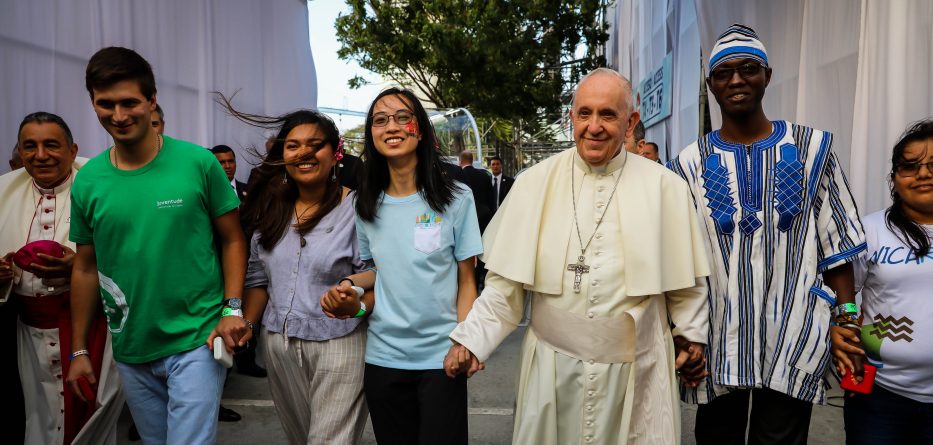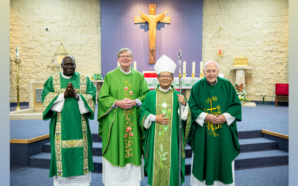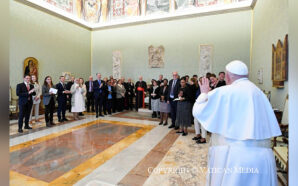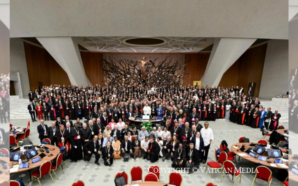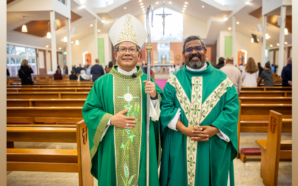Jesuit Father Karl Rahner was one of the first to recognise that the Second Vatican Council had transformed the western Catholic Church into a world Church: “For the first time a world-wide Council with a world-wide episcopate came into existence and functioned independently.”[1]
Bishops from non-western countries were certainly present at Vatican I, but they were largely missionary bishops of European and North American origin. At Vatican II, the bishops came from 116 countries, most of them native-born: 36 per cent from Europe, 23 per cent from Latin America, 12 per cent from North America, 20 per cent from Asia and Oceania, and 10 per cent from Africa. By the time of the 1985 Extraordinary Synod of Bishops in Rome, 74 per cent of the bishops came from countries other than Europe or North America, as do more than 70 per cent of the world’s Catholics today.
The world’s oldest institution, the Catholic Church, is truly a global Church.[2] With 1.3 billion members, it represents more than 50 per cent of the world’s 2.5 billion Christians. Its enormous numbers and international organisations make it a transnational actor. Recent estimates put Protestant numbers at roughly 37 per cent, with another 12 per cent belonging to the various Orthodox Churches. Other communities, less mainstream, include Christian Scientists, Mormons and Jehovah’s Witnesses, representing about 1 per cent. Today the Pentecostal, Charismatic or Renewalist communities, with over 682 million members, are rapidly growing.[3]
Changing Demographics
Yet the face of world Christianity is changing today. The main Churches of Europe and North America continue to lose members, and Catholic losses are significant. While Latin America is the home of some 425 million Catholics, with the growth of evangelical and Pentecostal Christianity, the Catholic Church began losing tens of millions of members. Pentecostals now claim some 70 per cent of all Latin American Protestants. With its emphasis on the supernatural, expressive worship and prayers for healing, they often preach the “Prosperity Gospel” or gospel of health and wealth, with its roots in American Pentecostalism.[4] In its various forms, Pentecostalism has proved particularly attractive to the poor of Latin America. Pentecostals are effective evangelists with their zeal for sharing their faith, an emphasis on charismatic giftedness and a subjective experience of God, something long lost sight of in western theology.
In the United States, the percentage of Catholics has dropped from 23 to 20 per cent, with the greatest losses in the Northeast.[5] Losses are most dramatic among young adults. Fully 36 per cent of Millennials (those between the ages of 18 and 24) are disconnected from any religious tradition. They are often called “nones,” for their negative response to questions about their religious affiliation.
In 1910 Europe was home to 65 per cent of the world’s Catholics, compared to just 24 per cent today.[6] Reasons include low fertility rates, the fact that most Christians are older, and the increasing numbers of those leaving Christianity. The number attending Mass continues to decline. The decline affects not just Catholics. A report by Stephen Bullivant found that in 12 of the 22 European countries studied, over half of young adults claim not to identify with any particular religion or denomination.
However, while Christianity is declining in the West, it is exploding in Africa, Asia and Latin America, usually referred to as the Global South. According to the Pew Forum, more than 1.3 billion Christians (61 per cent) live in the Global South, compared with about 860 million in Europe and North America (39 per cent).[7]
In Africa, the growth of Christianity has been extraordinary, from nine million in 1900 to an estimated 380 million today. According to Todd Johnson and his associates, “By 2050 there will likely be more Christians in Africa (1.25 billion) than in Latin America (705 million) and Europe (490 million) combined.”[8] This means that Europe will not dominate global Christianity numerically as it did in the past.
In Asia, Christianity continues to grow, especially in its evangelical and Pentecostal expressions. In 1970, there were 17 million Asian evangelicals and Pentecostals; today the number is over 200 million. Singapore, South Korea and the Philippines have Mega-Churches with members in the tens of thousands. In Indonesia and Malaysia Christianity is growing among Buddhists and Confucians. Many of these Churches preach the Prosperity Gospel. In China, Christianity continues to grow, despite efforts of the present government to control it. Catholic numbers are estimated to range between 10 and 12 million, but with little growth. Evangelical and Pentecostal Christians are between 40 to 60 million, with some suggesting numbers as high as 100 million.
Challenges
While the Second Vatican Council did much to renew and revitalise the Church, today it faces many challenges, in addition to declining membership. The sexual abuse of minors by clergy, the worst crisis faced by the Church since the Reformation, has done serious damage. Initially dismissed by some in Rome as an American problem, it is now worldwide.[9]
The shortage of priests is another challenge, with many of those still active reaching retirement age and new priestly vocations decreasing. In Europe, many parishes are being closed or combined into pastoral centres. Some countries are increasingly dependent on foreign-born clergy.
Cultural diversity and religious pluralism are also challenges. As a global community, the Catholic Church is present in increasingly secular countries and among not always friendly religions. In Latin America, Catholics work to establish better relations with the mushrooming Pentecostal Churches, with little success, while in China, India and some Islamic countries, Catholics must deal with hostile governments, political pressure, lack of religious freedom and persecution. Many national Churches face internal factions that are threats to unity. Finally, how the Churches will recover from the changed practice and closures of the pandemic remains to be seen.
From the beginning of his pontificate, Pope Francis has tried to move the Church forward, away from a “self-referential” focus on itself and its own problems and on to a world so much in need of the Gospel. He envisions a missionary discipleship, capable of combating the “myths of modernity” (“individualism, unlimited progress, competition, consumerism, the unregulated market”)[10] and bringing the good news to the peripheries, to all the excluded—the poor, migrants, the suffering. He wants a Church known, not for what it is against, but for what it is for, a Church that builds bridges. What might that Church look like?
Looking Ahead
In 2009, John Allen published a book on the future Church. Noting the demographic shift of the majority of Christians from Europe and North America to the Global South, he suggested that tomorrow’s Catholicism would be quite different. It will be largely non-western, non-white, and non-affluent, more conservative on sexual issues, more liberal on questions of social justice; it will be anti-war, pro-United Nations, and suspicious of free-market capitalism; more biblical and evangelical in engaging with cultural issues, more concerned with a strong Catholic identity in the face of religious pluralism. It will be younger and more optimistic, and more open to indigenous religious practice.[11]
What might we add, considering Pope Francis’ efforts to renew the Church, especially facing the challenges we have considered?
A Polycentric Church
Tomorrow’s Church will be polycentric rather than Eurocentric. Francis calls for greater recognition of the magisterial authority of national and regional episcopal conferences and stresses thinking with the Church, not just the hierarchy. He emphasises “synodality,” that is to say, “walking together,” resisting the temptation to govern in a “top-down” fashion.[12] In a plurality of cultures, synodality will play an increasingly important role, with more diversity in theology, liturgy and pastoral practice. To some extent, this is already happening as the Churches of Africa, Asia and Latin America work to inculturate their faith.
Pentecostalism has left its mark on the liturgies and catechetics of Latin America. African theologians are striving to develop an authentically African theology, with women playing an increasingly important role. Asian Churches, particularly in India, struggle with how to present Jesus as Word of God and saviour in a context of religious pluralism and their minority status. There may well be new centres of authority, based on national or regional episcopal conferences, such as the United States Conference of Catholic Bishops (USCCB) in Washington, DC, or the Federation of Asian Bishops’ Conferences (FABC) in Asia. This sort of process will develop if Francis’ vision of a more synodal Church can be realised.
A More Inclusive Governance
A decentralised, polycentric Church will be characterised by a more inclusive governance. The Churches of the Global South are increasingly finding their voices and bringing forward issues vital to their ecclesial life and mission. They often bring new concerns, assisted by the simultaneity of modern communications and social media. Many are striving to be more inclusive of those who are different.
With roughly 5,600 Catholic bishops today, the logistical difficulty of holding another Ecumenical Council suggests that the Synod of Bishops will play an increasingly important role in the future. Even more, it may require a change in the Synod structure, to make it more than simply a synod of bishops in which voting rights belong only to clergy.[13] Lay men and women have sometimes taken part in synodical language groups, and more ways can be found for them to participate effectively.
The two Synods on marriage and the family (2014–2015) and the October 2019 Synod on the Amazon were very different from the Synods that preceded them. They witnessed a free discussion of controversial issues not seen since Vatican II. In what they called a “synodality exercise,” the bishops of France opened their November 2019 plenary assembly, allowing each bishop to bring two members of the faithful, men or women, ordained or lay, to reflect with them on the future mission of their dioceses. Germany also is developing a synodal process.
Lay men and women could also be better represented on Vatican dicasteries and should have some say in choosing their bishops. The present system does not always manage to be representative of all the ecclesial voices. A system of nominations from local dioceses with the pope’s right to make the final decision could ensure both local participation and papal oversight.
To the Peripheries
Pope Francis has challenged Catholics, indeed all Christians “to go forth from our own comfort zone in order to reach all the ‘peripheries’ in need of the light of the Gospel” (Evangelii Gaudium [EG], No. 20). At the centre of his concerns are the poor, the disadvantaged and migrants. And if the Church is to successfully evangelise the diverse cultures in which it lives, it must become inculturated (EG 68, 116–128). His choice of cardinals from non-traditional sees and his inclusion of the voices of regional episcopal conferences in his apostolic letters are other indications of this. So is his emphasis on synodality.
The Synod of Bishops for the Pan-Amazon Region is an example of this. Embracing all or parts of Bolivia, Brazil, Columbia, Ecuador, French Guiana, Guyana, Peru, Venezuela and Suriname, the Amazon region is home to some 34 million people, including three million indigenous. But the region is under threat, with thousands of acres of rainforest, often referred to as “the planet’s lungs,” destroyed by fires caused largely by slash-and-burn methods of clearing the land for agriculture and cattle-raising. Dangers to health come from the use of agro-toxins, the polluting of rivers, lakes, and waterways and illegal mining. Social problems include the displacing of indigenous peoples, criminalisation of refugees and migrants, the sex trafficking of persons, especially women, and increased use of alcohol and drugs.
The Synod was seeking a “Church with an Amazonian Face,” with a form of synodal government that is more participatory, collegial, characterised by a stronger communion and new structures to assist it in confronting these realities, as Father Antonio Spadaro argues.[14] After many listening sessions, the Synod’s final document was approved by a two-thirds majority, including a vote – 128 for and 41 against married priests – the so-called viri probati or older men of proven virtue, as well as 137 for and 30 against women deacons. Also recommended was a special rite for the Amazon, though with some dissenting votes.[15] There were calls for further study and recommendations, which are now in the pope’s hands.
But the Synod also aroused considerable opposition. One German cardinal called the working document “heretical,” accusing its drafters of trying to change the Church into a secular NGO, while an American cardinal described it as an attack on the Lordship of Christ. Other attacks came from right-wing groups founded in 1960 as a bulwark against “communist” influences in society and the Church. Some objected to what it called the Synod’s “Indigenist Theology,” calling it “a radicalisation of Christian faith behind the mask of ecology.”[16]
The millions of migrants and refugees abandoned at the peripheries today are also a concern for Pope Francis. The whole world is on the move, with families fleeing violence and war, religious persecution, crushing poverty or climate change (LS 25). In 2019, the United Nations High Commissioner for Refugees reported that the number of people forcibly displaced had reached 70.8 million, the highest level on record.[17] These include those on the southern border of the United States, many of them separated from their children under the Trump administration.
Ministerial Leadership
No one expected the explosion of lay ministries that followed Vatican II’s efforts to develop a theology of the laity and their share in the priesthood of Christ and the Church’s mission. Today, positions of leadership in local communities and dioceses are increasingly filled by lay men and especially lay women.
In Africa and Latin America, lay catechists and pastoral agents have long been leading local communities. Catechists in Africa are usually supported by their communities; they are not necessarily salaried but provided with housing, food and transport. Africa also has a new generation of theologians and Church professionals, men and women, priests and sisters, many trained in Europe or the United States.
In Europe and Latin America lay ministers, women among them, conduct funerals, lead services of the Word, and preach at prayer services when a priest is not available. Some churches in the United States have “lay parish administrators” who function as virtual pastors in all but sacramental ministry.
Renewed Priesthood
The shortage of priests continues to remain a problem in many parts of the world. In 2017, the global number of priests decreased for the first time since 2010. In one diocese in northern Brazil, 70 per cent of the communities see a priest only once or twice a year, so baptism becomes the basic sacrament.
The seminary system, which has already undergone significant change, needs to be further reformed. Placing seminarians in all-male, semi-cloistered environment, a “formation by isolation,” does not prepare them to face today’s challenges.[18] Many have little sense of the challenges of family life, or of equitable working relationships with lay ministers. Affective and psychosexual maturity, as well as clericalism, are crucial issues needing to be addressed, as the sexual abuse crisis has demonstrated. The theology of an “ontological change,” based on ordination, makes little sense today and encourages a clerical elitism. Seminarians should attend classes with men and women preparing for ministry, and their teachers and formatores, both men and women, should have some say in approving them for ordination.[19]
The Church has considerably more freedom over its sacramental discipline than it has been willing to acknowledge. Many deacons do excellent hospital ministry. Why not undertake a reflection on the administration of the sacrament of the sick and the remission of sins connected to it, evaluating some circumstances and conditions where a deacon could be the celebrant? These issues and others have never been discussed by the whole Church, using all its theological and pastoral resources, nor has any effort been made to assess the sensus fidelium on the question.
Loss of Privilege
The Church today no longer enjoys its privileged special status among institutions. The sexual abuse crisis, as well as increasing secularisation, have led to a significant redefinition of the relations between Church and state. The secular culture of many western countries has also challenged long-standing policies of Catholic institutions because of Church teaching on questions of life, sexuality and family.
In Argentina, Australia, Belgium, Canada, Chile, India, Ireland and the United States, civil authorities have initiated investigations of local Churches, demanding access to chancery records. In India, Pakistan and China, Catholics face discrimination and, too often, persecution.
Dialogue with Culture
If the Church’s voice is to be heard today, it must learn a new way to teach. It does no good to lament an increasing secularity, loss of traditional morality, or new attitudes toward sexuality, gender, medical ethics and end of life issues. The days when the Church could simply impose its morality on a society through civil law – the ancient alliance of throne and altar – are gone in much of the world today. The Church needs to dialogue with culture, bringing its own contribution with its many personal and institutional resources. This is the way of Pope Francis, who calls for “a sincere dialogue with social and civil institutions, with university and research centres, with religious leaders and with all women and men of good will, for the construction in peace of an inclusive and fraternal society, and also for the care of creation.”[20]
For many today, authority comes not from doctrine but experience. It prizes individual rights, self-determination and the authenticity of the person. At the same time, the Church cannot simply embrace the ethos of the culture. Much of it is indeed contrary to the Gospel. An extreme individualism works against the deep Catholic commitment to the common good, the dignity of the person, and its emphasis on the importance of community. The Church’s voice needs to be in the public square to address these issues.
But the Church does not have the answer to all questions, and it recognises a certain autonomy of the secular (GS 36). It needs to consult the sense of the faith (sensus fidei) and the faithful (sensus fidelium). The bipartite image of a teaching Church (ecclesia docens) and a learning Church (ecclesia discens) is no longer appropriate, if it ever was.[21] The Church needs also to listen to its theologians, its scholars and to other Churches.
A New Ecumenism
The explosive growth of the “new” Churches in the Global South – evangelical, Neo-Pentecostal and the African Independent Churches – presents a new challenge for ecumenism. Many are non-traditional. Few are sacramental or liturgical communities; most do not celebrate the Eucharist. Believing in a rich spirit world, many stress spiritual warfare and exorcisms. The majority preach the Prosperity Gospel. Few are interested in ecumenism or the visible unity of the Church. They find western ecclesiology too western, Eurocentric and not sufficiently attuned to their experience.
The ancient and confessional Churches cannot simply ignore these new Churches, but relating to them will require a new, more inclusive ecumenism. More important than the consensus statements that have characterised traditional ecumenism, these new Churches value personal testimonies, sharing stories about life in the Spirit, and a sense of mission based on Gospel values. The approach of Pope Francis is similar; he stresses walking, working and praying together.
The Churches of the West and the Global South can learn much from each other.[22] With a strong sense of their evangelical mission and the gifts of the Spirit, the new Churches are vital communities, though they need to move beyond their health and wealth preaching, learn that faith and reason work in consort, and seek visible unity with other Churches. The Churches of the West may be more in touch with the Church’s historical tradition and with the social dimensions of its mission, but Enlightenment rationalism too often taints their theology, so more attention to experience and to a sense for God’s nearness is needed.
The Gospel calls all Christians to live in communion with one another. Can the Bishop of Rome become not just a symbol of unity, but truly its servant, without demanding that all the Churches recognise his juridical authority? Authority is always greater when it is recognised rather than claimed. Unity is for the sake of mission, “that the world may believe” (John 17:21). Christians need to recognise each other as brothers and sisters in the Lord. Ecumenism always begins in friendship.
Interreligious Dialogue
Pundits and journalists are accustomed to proclaiming the dying of religion, but many conflicts today have religious roots, driven by various fundamentalisms which represent a response to modernity, heightened by globalisation, on the part of many who fear change and the loss of power or privilege, whether religious, political or of other kinds.
Islamic fundamentalism is a problem in Africa and parts of the Middle East, often leading to violence, yet dialogue with Islam is still in its very early stages, and Europe is markedly divided on relations with Islam. It is not the religion itself or its practices that many object to, but the social and political order that in many Muslim countries involves the denial of freedom of conscience, religious conversion, and the full equality of women and religious minorities. In some states of India both Christians and Muslims suffer persecution.
Dialogue remains a priority of Pope Francis. When he went to Morocco in March 2019, he stressed that authentic dialogue is the way to combat terrorism; “mere tolerance” is not enough. “While respecting our differences, faith in God leads us to acknowledge the eminent dignity of each human being, as well as his or her inalienable rights.”[23] This is a message that all the religions should share.
Ecclesial Identity
Ecclesial identity is a final issue. Today many young Catholics are unfamiliar with their own tradition and with the protocols of ecclesial procedure, or frequently they just ignore them. An experience of community is more important than institutional identity. Unofficial eucharistic sharing is not unusual. Some speak of “double-belonging.” In the U.S., if a couple is unable to have a “garden” wedding under Catholic auspices, they turn to Episcopalian or Methodist pastors, without considering themselves any less Catholic for that. In Nigeria and elsewhere, some Catholics attend both their own church and a Pentecostal congregation. Thus, ecclesial walls today are often porous. The easy crossing of denominational lines may itself be a sign of how much the ecumenical landscape has changed.
When Pope Francis visited Morocco, he warned Catholics not to be concerned about making converts: “the paths of mission are not those of proselytism, which leads always to a cul-de-sac, but of our way of being with Jesus and with others. The problem is not when we are few in number, but when we are insignificant, salt that has lost the flavour of the Gospel, or lamps that no longer shed light (cf. Matt 5:13-15).”[24] The challenge is to remain always open and welcoming, without losing a sense for the gifts and convictions of our Catholic tradition.
Conclusion
The phenomenon of globalisation is bringing the diverse cultures of the world closer together, though not always in peaceful ways. Catholicism as a global Church reflects that diversity to a remarkable degree. Its special charism has been its ability to hold unity and diversity together in creative tension.
According to Massimo Faggioli, Pope Francis’ vision is global, but with a new perspective. Francis sees both the Church and the world in a process of a global resettlement, and he invites us to see it, not from the centre to the peripheries, but from the peripheries to the centre, or more accurately, from the perspective of a polycentric Church.[25]
Today’s Church needs more than ever to draw upon its many wisdom sources, its pastors and ministers, its scholars and theologians, its educational institutions and social ministries, and the faith of its peoples. It must continue to seek greater union with other Churches and Christian communities, and to work for greater interreligious understanding if it is to fulfill Vatican II’s vision of the Church as a sacrament of unity with God and all God’s people.
Thomas P. Rausch, SJ is the T. Marie Chilton Professor of Catholic Theology and Professor of theological studies at Loyola Marymount University, Los Angeles, USA.
Reproduced with permission from La Civiltà Cattolica.
DOI: La Civiltà Cattolica, En. Ed. Vol. 6, no. 6 art. 1, 0621: 10.32009/22072446.0621.1
[1] K. Rahner, “Towards a Fundamental Theological Interpretation of Vatican II”, in Theological Studies 40 (1979/4), 718.
[2] See T. P. Rausch, Global Catholicism: Profiles and Polarities, Maryknoll (NY), Orbis Books, 2021.
[3] See T. M. Johnson et al, “Christianity 2018: More African Christians and Counting Martyrs”, in International Bulletin of Mission Research 42 (2018/1), 23-24.
[4] See S. Coleman, The Globalization of Charismatic Christianity: Spreading the Gospel of Prosperity, New York, Cambridge University Press, 2000.
[5] See Pew Research Center, “In U.S., Decline of Christianity Continues at Rapid Pace”, October 17, 2019.
[6] See Pew Research Center, “5 facts about Catholics in Europe”, December 19, 2018.
[7] See Pew Research Center, “Global Christianity – A Report on the Size and Distribution of the World’s Christian Population”, December 19, 2011.
[8] T.M. Johnson et al, “Christianity 2018…”, op cit., 21.
[9] See S. Poggioli,
in “Pope Meets U.S. Bishops in Rome Over Sex Abuse”, NPR, September 13, 2018.
[10] Francis, Encyclical Laudato Si’ [LS], No. 210.
[11] See J. Allen, The Future Church: How Ten Trends Are Revolutionizing the Catholic Church, New York, Doubleday, 2009, 432–35.
[12] See Francis, “Ceremony Commemorating the 50th Anniversary of the Institution of the Synod of Bishops”. See also International Theological Commission, “Synodality in the Life and Mission of the Church”, March 2, 2018.
[13] M. Faggioli, “What the Synod of Bishops means for Vatican II . . . and ‘Vatican III’”, in La Croix International, October 30, 2019.
[14] A. Spadaro – M. López Oropeza, “Four Criteria to Interpret the Amazon Synod”, in La Civiltá Cattolica English Edition, October 2019, in laciviltacattolica.com/four-criteria-to-interpret-the-amazon-synod/
[15] L. Hansen, “Top 5 takeaways from the Amazon synod”, America, November 11, 2019.
[16] C. White, “Catholic Reactional Group Raising its Profile Ahead of Amazon Synod”, in Crux, September 25, 2019. See also H. Schlumpf, “Head of Liturgy Commission Criticizes Amazon Synod on Social Media”, National Catholic Reporter, December 5, 2019.
[17] UNHCR – The United Nations Refugee Agency, Global Trends: Forced Displacement in 2018, in www.unhcr.org/5d08d7ee7.pdf
[18] See T. P. Rausch, “Vatican II on the Priesthood: Fifty Years Later”, in The Seminary Journal 18 (2012/3), 4-18.
[19] Boston College Seminar on Priesthood and Ministry, “To Serve the People of God: Renewing the Conversation on Priesthood and Ministry”, Origins 48 (2018/31), 484-93.
[20] See Pope Francis, “Theology after Veritatis Gaudium in the Context of the Mediterranean”, June 21, 2019; see also Fratelli Tutti, No 211.
[21] International Theological Commission, The Sensus Fidei in the Life of the Church, Nos. 4, 43, 67, 72, 74. See T. P. Rausch – R. Dell’Oro (eds), Pope Francis on the Joy of Love: Theological and Pastoral Reflections on Amoris Laetitia, New York, Paulist Press, 2018.
[22] See T. P. Rausch, “A New Ecumenism: Christian Unity in a Global Church”, Theological Studies 78 (2017/3), 596–613.
[23] Francis, Meeting with the Moroccan People, the Authorities, with Civil Society and with the Diplomatic Corps, Rabat, March 30, 2019. See I. San Martín, “Pope extols interreligious dialogue as a means to combat terrorism”, in Crux, March 30, 2019.
[24] Francis, Meeting with Priests, Religious, Consecrated Persons and the Ecumenical Council of Churches, Rabat, March 31, 2019. See D. Castellano Lubov, “In Morocco, Pope Warns Religious to Not Be Discouraged by Being Few, But as ‘Lamps’ to Not Lose Their Light”, Zenit, March 31, 2019.
[25] M. Faggioli, Joe Biden and Catholicism in the United States, New London, CT, Bayard, 2021, 71-75.




